|
|
|
|
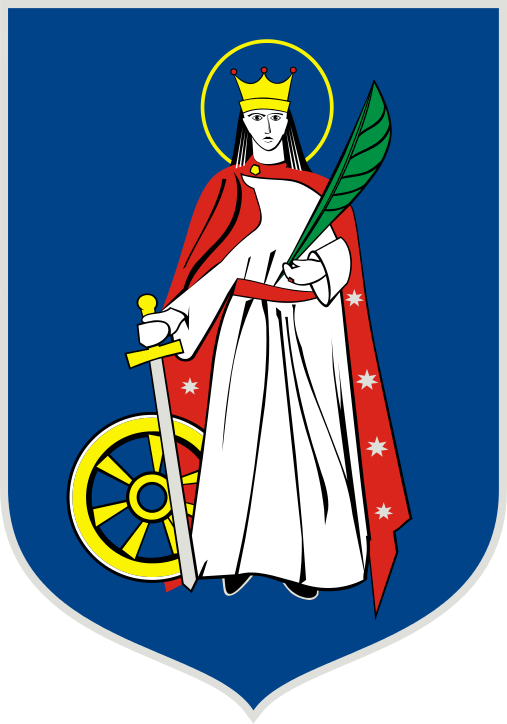 |
Nowy Targ, Poland |
|
|
|
|
 |
Nowy Targ, Poland |
Very few photos can be found of the main synagogue, located at 17
J. Kazmierska Street, and the Chassidic shtibl, as they appeared
before their destruction and transformation into a cinema and
locksmith's shop, respectively. Photographs of what they
looked like June 2016 are also shown, taken by a visitor from the
USA, Sally Mizroch.
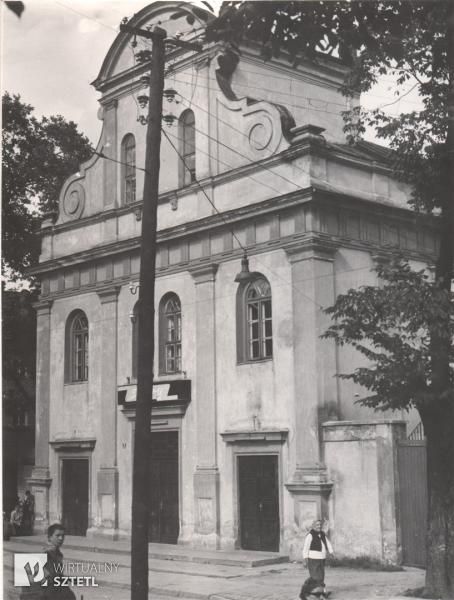 |
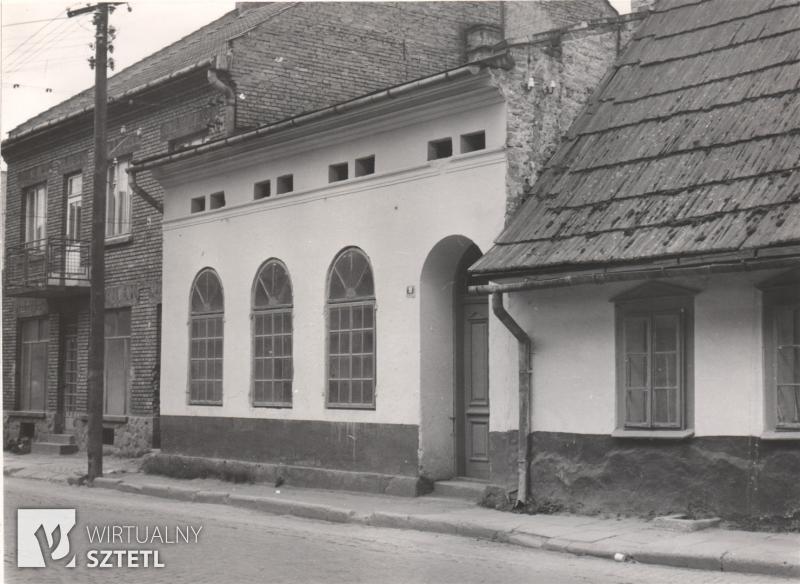 |
|
Photo of the Original Main
Synagogue on 17 Jan Kazmierska Street.
Because links to the VirtualSztetl sometimes change, this is from where I copied the photo of the Main Synagogue. |
Photo of the Chassidic shtibl
in Nowy Targ on Szfalarska Street, 19.
This image was copied from Virtual Sztetl, because the
links on their website change faster than updates to this
site. As of this upload, the original
photo is available on their site. |
 The Tatry Cinema, photo by Sally Mizroch, June 2016. The following is adapted from Virtual
Sztetl's description: The original brick
building was built around the beginning of the 1900s, on
a neo-baroque rectangular plan, and had electric
lighting. On the east wall was an elaborate Aron
ha-Kodesz.
During World War II the Germans destroyed the synagogue. After the war, the destroyed building returned to the remnant of the Jewish community. Unable to renovate it, the authorities took it over and the "Tatra" cinema, was opened, is still functional. During the renovation of the synagogue, the original appearance of the building was completely obliterated as is obvious in comparing the pictures. |
Sally Mizroch's photo of the abandoned locksmith's shop on Szaflara Street 19. Photo taken June 2016. According to information on the
Virtual Sztetl website, after the war, the "synagogue
building was completely renovated and ... adapted to the
needs of the locksmith's workshop." The building
as it appears in disrepair is apparently abandoned and
falling into ruin. The original synagogue was
built in the early 1900s on a rectangular plan; "... the
main façade had three windows and a semi-circular
door. After the reconstruction ... the windows and
doors were changed. Only the rectangular attic lofts
have survived from the original design."
|
| Aryeh deBei Aliyah,
by Aryeh Leibush Lipschitz, unknown date, Jerusalem, 159 pp. Also published, 1880, Przemysl, 154 pp. "1" |
Sefer Tehilim compiled by Yoel Bloch, Ofen (i.e., Budapest), 1863, 225 pp. "4" |
Hachanat Lev LeTefila
by Shlomo Aryeh Lev Weinshelbaum, (from Blendow, Poland), published, Bilgoraj, 1927 "5" |
||||
|
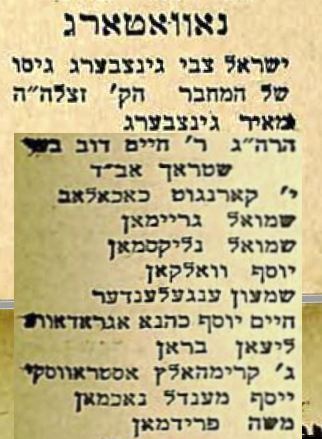
|
| Last Name, First | Source # | Information |
|---|---|---|
| BRON, Lieon |
5 | |
| ENGLÄNDER, Shimon |
5 | |
| FEIT, Baruch Zvi |
4 | In Dunaietz |
| FRIEDMAN, Moshe |
5 | |
| GLAUBAUF, Yisrael |
4 | |
| GLÜCKSMAN, Shmuel | 1, 3, 4 | In 4, under Dunaietz |
| GLÜCKSMAN,
Shmuel (#2) |
5 | Cannot be the same as the
one above, since he died 1891, and is buried in Nowy
Targ. |
| GOLDFINGER, Yakov | 2, 4 |
|
| GOLDMANN, Shlomo | 1, 2, 3, 4 | |
|
Kalman |
4 | Shochet, (not clear if
Kalman is a given or family name) |
| GREIMAN, Shmuel |
5 | |
| GÜNSBERG, Yisrael Zvi |
5 | Brother-in-law of the author |
| GÜNSBERG, Meir |
5 | |
| KAHANE, Chaim Yosef |
5 | From ? (àâøàãàååò) |
| KLEINZAHLER, Aryeh Leibush | 1, 3 | Shochet |
| KORNGUT, Abraham David | 1, 3 | son of Yitzchak |
| KORNGUT, Chaim | 4 | |
| KORNGUT, Y. | 5 | From ? (ëàëàìàá) |
| KORNGUT, Yitzchak | 1, 3 | Czarny Dunajec |
| KRUMHOLTZ, G. |
5 | From Ostrowski? |
| LANGER, Shmuel |
4 | |
| MANDEL, Aharon | 1, 2, 3, 4 |
|
| MESSINGER, Mendel |
4 | In Dunaietz |
| NACHMAN, Yosef Mendel |
5 | |
| REISZ, Moshe | 1, 3, 4 |
In 4, under Dunaietz |
| STROCH, Rabbi Chaim Dov
Ber |
5 | Chief Rabbi of Nowy Targ |
| UNGER Brothers |
4 | In Dunaietz |
| WOLF, Binyamin | 1, 3 | Shochet of Jardonow |
| WULKAN, Yosef |
5 |
(with thanks to Yoel HIRSCH for finding these pieces.)
Prior to Rabbi Yaakov Yokel HIRSCH becoming the rabbi in Nowy
Targ, they seem to have had other "Religious Authorities" referred
to in German as Religionweiser. Yoel HIRSCH, a
descendant of the aforementioned rabbi, found listings in three
editions of "Statthalterei-Gebietes fur Galizien" for the years:
1862, 1866, 1868. Here are the little excerpts from pages in
those editions:
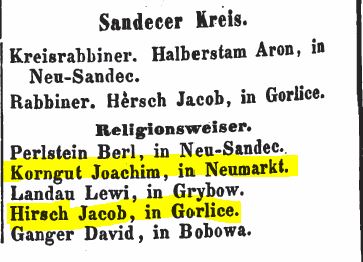 |
 |
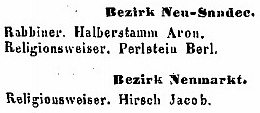 |
| 1862: Here we see Joachim (Chaim) KORNGUT
serves as the Religions Authority while Rabbi Jacob (i.e.
Yaakov Yokel) HIRSCH is serving in Gorlice. |
1866 Joachim KORNGUT died in 11 May 1864,
so now Moses PERLMAN is the Religious Authority and Rabbi
HIRSCH is still in Gorlice. |
1868: Jacob HIRSCH is the Religious
Authority. |
 Nowy Targ seems to have been in need of a shochet
from time to time. In several consecutive issues of the weekly
newspaper, HaMitzpah (printed in Krakow, Poland in Hebrew
between the years 1904-1914, 1917-1921) they posted an
advertisement for a shochet in December 1905-January 1906. They
posted the same in the Machzikay Hadat Newspaper that was
founded by Rabbi Shimon Sopher (son of the Chatam Sopher) in 1897
and continued until the beginning of WW I, in 1914.
Nowy Targ seems to have been in need of a shochet
from time to time. In several consecutive issues of the weekly
newspaper, HaMitzpah (printed in Krakow, Poland in Hebrew
between the years 1904-1914, 1917-1921) they posted an
advertisement for a shochet in December 1905-January 1906. They
posted the same in the Machzikay Hadat Newspaper that was
founded by Rabbi Shimon Sopher (son of the Chatam Sopher) in 1897
and continued until the beginning of WW I, in 1914.
It is amazing at the stringent requirements they had for such a
position, and how much they expected such a man to do.
Unfortunately, we do not know who tried out and who was accepted
for this position. This example is from the 6 January 1906 issue
of the second newspaper.
Translation:
"The community of Neumarkt Galicia seeks an expert shochet who can
also serve to lead prayer services, having a pleasant voice, can
also read the Torah, and be a mohel (circumciser), and whose age
is between 24-30.
He should be Galician-born and have recommendations from famous
contemporary gaonim (scholars).
His salary will come from the community's fund, 1,200 Crowns per
year. At this time, this salary is "provisional" for the year, and
if he decides to quit, we won't stand in his way.
Anyone who is interested should send a letter to the signator
below or come here in person also for an interview with the chief
rabbi, before 1 February 1906. This is also to advise you
that travel expenses will only be reimbursed for the person
selected.
Signed, Dr. B. KOHN, President of the community."
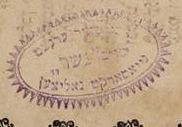 |
One shochet was discerned from his rubber
stamp that was found in a rather battered Hebrew
book. Hard to read, but he was Zvi Meyer ERNST.
In other documents he was referred to as "M. ERNST." He was a shochet before the posting of the job offering above. (The rubber stamp is similar to that of Rabbi STROCH, on the Family page.) |
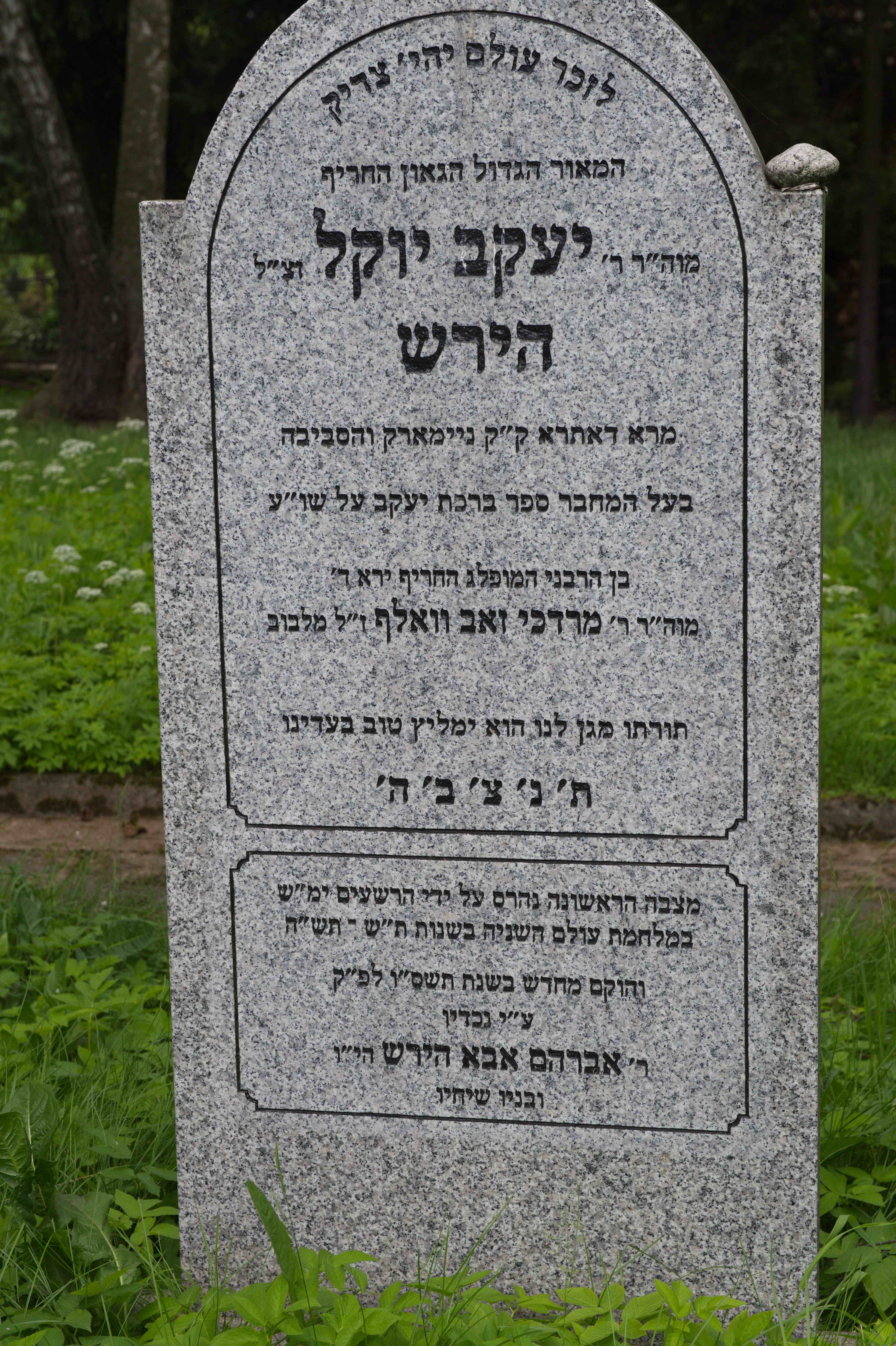 For more about the HIRSCH family, see the Family menu item |
At the end of June 2016, Sally Mizroch who
has ancestry in Nowy Targ, traveled from Seattle, WA, to
Nowy Targ, Poland. One of her goals was to visit and
photograph the cemetery and its remaining stones.
Among the few that actually remain, was that of one of
Nowy Targ's rabbis, Rabbi Yaakov Yokel HIRSCH.
He authored a scholarly book called "Birchat Ya'akov" or,
"Jacob's Blessing." He was the son of Mordechai Zeev
Wolf HIRSCH, of Lviv. The cover page is at right and
may be seen in its entirety at the HebrewBooks.org website, item 751,
or click on the image at right. This rabbi was the first of Nowy Targ's rabbis. He arrived in Nowy Targ in 1862 and served until his death in 1880. He was succeeded by Rabbi Chaim Dov-Ber STROCH, who came in 1885, and served until his passing in 1932 -- a 46 year span of religious leadership. Rabbi Hirsch's original stone was destroyed by the nazis during World War II. The stone was renewed in 5766 (2006) by his grandson, Rabbi Avraham Aba HIRSCH, and his children (may they live well). To see a complete set of the Sally Mizroch's cemetery photos, she has made them available on Flickr. The data from the inscriptions has already been extracted. |
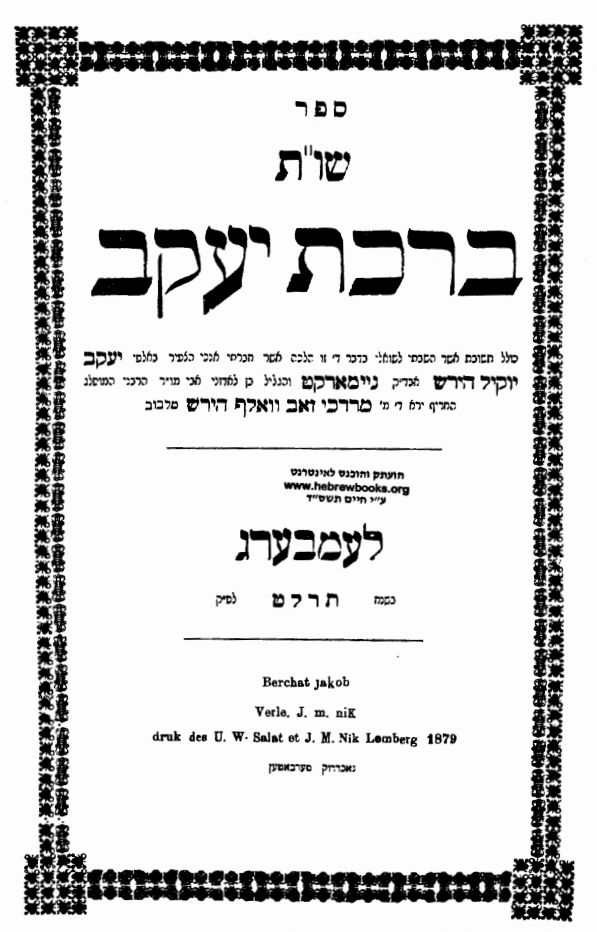 |
|
18 March 2017
Copyright
© 2017-2022updated 8 November 2022 Madeleine R. Isenberg All rights reserved. |
This site is hosted at no cost by JewishGen, Inc., the Home
of Jewish Genealogy. If you have been aided in your research
by this site and wish to further our mission of preserving
our history for future generations, your JewishGen-erosity is greatly
appreciated.